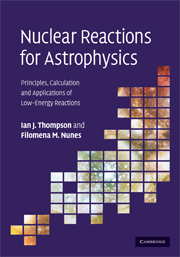Book contents
- Frontmatter
- Contents
- Preface
- Sources of quotations
- Acknowledgements
- 1 Nuclei in the Cosmos
- 2 Reactions of nuclei
- 3 Scattering theory
- 4 Reaction mechanisms
- 5 Connecting structure with reactions
- 6 Solving the equations
- 7 Approximate solutions
- 8 Breakup
- 9 Three-body nuclei
- 10 R-matrix phenomenology
- 11 Compound-nucleus averaging
- 12 Stellar reaction rates and networks
- 13 Connection to experiments
- 14 Spectroscopy
- 15 Fitting data
- Appendix A Symbols
- Appendix B Getting started with Fresco
- Select bibliography
- Index
12 - Stellar reaction rates and networks
Published online by Cambridge University Press: 05 March 2012
- Frontmatter
- Contents
- Preface
- Sources of quotations
- Acknowledgements
- 1 Nuclei in the Cosmos
- 2 Reactions of nuclei
- 3 Scattering theory
- 4 Reaction mechanisms
- 5 Connecting structure with reactions
- 6 Solving the equations
- 7 Approximate solutions
- 8 Breakup
- 9 Three-body nuclei
- 10 R-matrix phenomenology
- 11 Compound-nucleus averaging
- 12 Stellar reaction rates and networks
- 13 Connection to experiments
- 14 Spectroscopy
- 15 Fitting data
- Appendix A Symbols
- Appendix B Getting started with Fresco
- Select bibliography
- Index
Summary
I found that the best ideas usually came, not when one was actively striving for them, but when one was in a more relaxed state.
Paul DiracThermal averaging
Reaction rates 〈σv〉 and lifetimes
The reactions that we have discussed so far all have cross sections σ(E) that depend strongly on center-of-mass energy E. This dependence may be because of a repulsive Coulomb barrier, so that σ(E) = E-1 exp(-2πη)S(E) for an ‘astrophysical S-factor’ S(E) that is relatively less variable with energy. It may be because neutrons have a σ(E)∝ 1/v behavior for projectile-target relative velocity v near zero. Or itmaybe because of resonances giving sharply peaked cross sections, like Г/[(E - ER)2 + Г2/4] for a single resonance centered at ER with a full width at half maximum of Г.
In a stellar plasma of a mixture of two or more nuclear species, there will be a considerable range of relative energies E (or, velocities v) because of the statistical distribution of thermal energy among all the particles in the plasma. The actual rate of nuclear reactions will therefore require an averaging of the cross sections σ(E) over the thermal distribution of relative energies. We will therefore define an average reaction rate as the number of reactions per second per unit volume, and find an expression for this in terms of σ(E) and the distribution φ(v) of the relative velocities of the interacting particles.
- Type
- Chapter
- Information
- Nuclear Reactions for AstrophysicsPrinciples, Calculation and Applications of Low-Energy Reactions, pp. 340 - 363Publisher: Cambridge University PressPrint publication year: 2009



